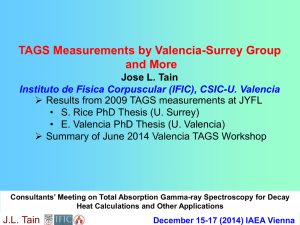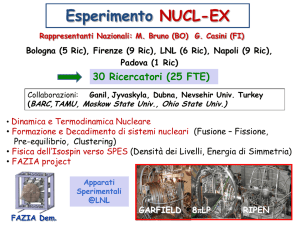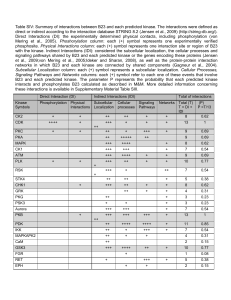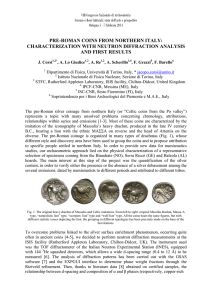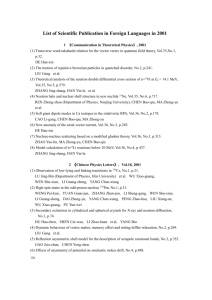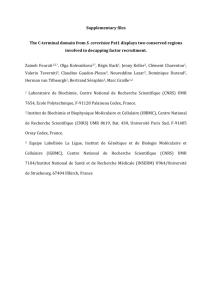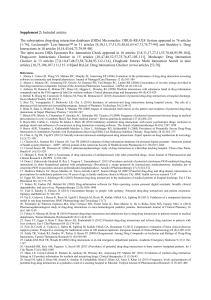Neutron Transport Theory and Reactor Kinetics
advertisement
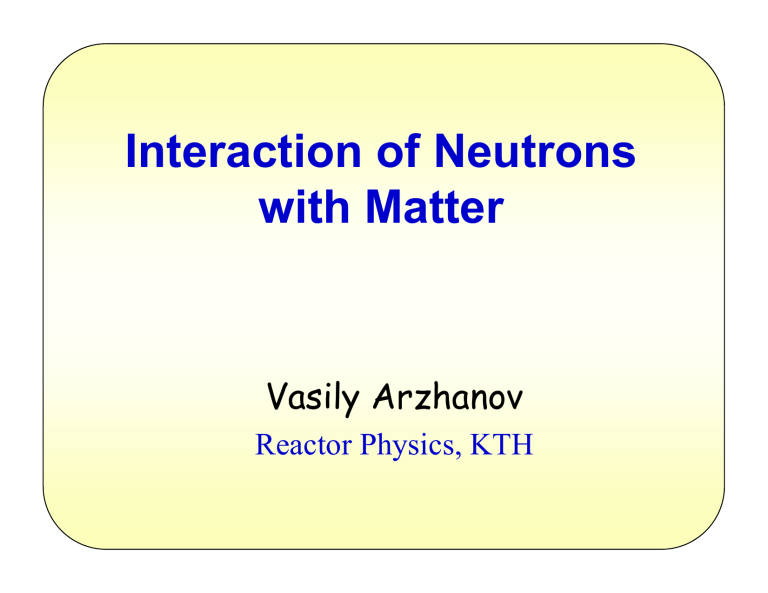
Interaction of Neutrons
with Matter
Vasily Arzhanov
Reactor Physics, KTH
Overview
•
•
•
•
•
•
•
Chain Reaction in a Nuclear Reactor
Classification of Neutron Interactions
Interaction Cross-Sections
Neutron Flux and Reaction Rates
Elastic Scattering: X(n,n)X or simply (n,n)
Inelastic Scattering: (n,n')
1/v and non-1/v absorbers
HT 2008
Neutron Interactions
2
Chain Reaction
n 2 MeV
β
H2O
235U
n 2 MeV
E ~ 0.1 eV
β
Scattering
ν
n
ν
H2O
γ
235U
ν
γ
ν
γ
β
Fission
400 KeV
γ
238U
β
239Pu
Capture
HT 2008
Neutron Interactions
Breeding
3
Fission Cross Section
10 4
235
σ (barns)
10
U
3
10 2
fission
10 1
10 0
capture
10 -1
10 -2 -3
10
10 -2
10 -1
10 0
10 1
10 2
10 3
10 4
10 5
10 6
10 7
Energy (eV)
HT 2008
Neutron Interactions
4
2 MeV
N1
ν n/fission
Energy
Leakage
N2
N2
k≡
N1
Fast fission
Resonance abs.
ν ≈ 2.5
Non-fissile abs.
Slowing down
E
Physical Principles of
Nuclear Reactor
Non-fuel abs.
1 eV
Fission
200 MeV/fission
HT 2008
Leakage
Neutron Interactions
5
Important
ν ≈ 2.5 n/fiss
εf ≈ 200 MeV/fiss
MeV = 1.602 × 10-13 J
Pthermal = Nfissions • εf • MeV
[W]
= [fiss/s] • [MeV/fiss] • [J/MeV]
Nfissions may be evaluated through n(r,E,t)
n(r,E,t)d3rdE = Number of neutrons in
d3r about r with energies in dE about E.
HT 2008
Neutron Interactions
6
Conclusion
The behaviour of a nuclear reactor is governed by the distribution in
• space
• energy
• time
of the neutrons in the system. The central problem is to predict this
distribution, or equivalently to derive an equation for the neutron
density, n(r,E,t) or more generally, n(r,E,Ω,t).
The first step to this end is to study the neutron interaction with
matter.
HT 2008
Neutron Interactions
7
Classification of Neutron
Interaction with Matter
Neutron Interaction
Scattering
Elastic
HT 2008
Inelastic
Absorption
Fission
Capture
(n,γ)
Neutron Interactions
N. mult.
(n,2n)
(n,3n)
...
(n,p)
(n,α)
8
Reactions (n,xn)
HT 2008
63
29
1
Cu+ 01 n →62
Cu+2
29
0n
63
29
Cu(n,2n) 62
29Cu
203
81
200
Tl+ 01 n →81
Tl+4 01 n
203
81
Tl(n,4n)
200
81
Tl
Neutron Interactions
9
Reactions (n,p) (n,d) (n,α)
N + 10 n → 146C + 11 H
p
14
7
d
31
15
α
production in the atmosphere
31
P + 10 n → 14
Si + 21 H
10
5
B+ n →
or
HT 2008
14C
1
0
10
5
( B)
11
5
*
→ 73 Li + 42 He
B(n,α ) 7 Li
Neutron Interactions
10
Definition of Cross-Section
Each instance of interaction will be called collision.
Detector
Area of the beam, A
cross section σ
Monoenergetic
beam of neutrons
θ
#
[I ] = 2
cm s
Detector
Vol = A×L
L
Experiments:
Rcoll(Vol) = σ×I×N×Vol
[σ ] = cm 2
HT 2008
Neutron Interactions
11
Macroscopic Cross Section
Collimated monoenergetic
neutron beam, n/(cm2sec)
I0
Number of neutrons at distance x:
I(x)
-dI(x)
x
It was observed in experiments that the
fraction of neutrons which suffer their
first collision in dx around x is constant.
x+dx
dI ( x)
−
= dx ⋅ Σ ⎡⎣cm −1 ⎤⎦
I ( x)
Neutrons have no memory
HT 2008
Neutron Interactions
12
Microscopic Cross Section
It was observed further in experiments
that this constant is proportional to the
density of the background medium.
Σ =σN
σ ⎡⎣cm 2 ⎤⎦
Cross-sectional unit: 1 barn = 10-24 cm2
Σ → Σt
σ → σt
HT 2008
(total cross-section)
Neutron Interactions
13
Example 1
0.5
A beam of 1-MeV neutrons of intensity 5×108 n/(cm2s)
strikes a thin 12C target. The area of the target is 0.5 cm2
and is 0.05 cm thick. The beam has a cross-sectional
area of 0.1 cm2. At 1 MeV, the total cross-section of 12C
is 2.6 b and density is 1.6 g/cm3.
cm2
12C
target
0.1 cm2
Question (a): At what rate do interactions take place in
the target?
Question (b): What is the probability that a neutron in
the beam will have a collision in the target?
0.05 cm
Rcoll(Vol) = σ×I×N×Vol
Number density of
the target material
HT 2008
Neutron Interactions
14
Solution 1
Rcoll (Vol) = σ × I × N × Vol
N=
ρ ⋅ NA
M
1.6 × 6.02 ⋅ 10 23
=
≈ 8 × 10 22
12
Rcoll ( Vol) = 2.6 × 10 −24 × 5 × 10 5 × 8 × 10 22 × 0.1 × 0.05 = 5.2 × 10 5
#
s
Rcoll
5.2 × 10 5
−2
Pr {neutron interacts} =
=
=
1.04
×
10
I × A 5 × 10 8 × 0.1
HT 2008
Neutron Interactions
15
Neutron Attenuation
Number of neutrons survived
traveling distance x.
dI ( x) I ( x)
−
= Σt
dx
−dI ( x)
dI ( x)
−
I ( x)
Σt
HT 2008
I ( x) = I ( 0 ) e
−Σt x
I ( x)
Pr {No collision} =
= e −Σt x
I (0)
Number of neutrons that survived penetrating the
distance x and made their first collision within dx.
= Probability of the first collision within dx =
Σt dx
= Probability of some interaction per unit path length
Neutron Interactions
16
Probability of Uncollided Flight
1
Probability of uncollided
flight within distance x
F(x)
P(x) = e−Σt x
Probability of at least one
collision within distance x
F(x) = 1 − P(x) = 1 − e
−Σt x
0
HT 2008
Neutron Interactions
P(x)
x
17
First Collision Probability
Independent events:
P { A ∩ B} = P { A} ⋅ P {B}
Let p(x)dx be the probability that a neutron will have its first collision in dx around x.
p ( x ) dx = Pr {( Survives x ) ⋅ ( Collides in dx )} =
= Pr {Survives x} ⋅ Pr {Collides in dx} = e −Σt x Σt dx
First collision probability:
p ( x ) = Σt e −Σt x
∞
∫ p ( x ) dx = 1
0
HT 2008
Neutron Interactions
18
Mean Free Path
The mean free path, average distance traveled by a neutron in the medium is
∞
∞
0
0
mfp = λ = ∫ xp ( x ) dx = Σt ∫ xe −Σt x dx =
1
Σt
For example, mean free path of 100-keV neutrons in liquid sodium is 11.6 cm.
σt = 3.4 b; N = 2.54×1022; Σt = 0.0864 cm-1;
HT 2008
Neutron Interactions
λ = 1/Σt = 11.6 cm
19
Mean Time
Collision probability
per unit path length is
Collision probability
per unit time is
Alternatively
HT 2008
1
Σt ⇒ = λt
Σt
1
vΣt ⇒
= τt
vΣt
Mean free path
Mean time
λt
1
=
= τt
v vΣt
Neutron Interactions
20
Cross-Sections of Mixtures
Homogeneous mixture of 2 nuclide species, X and Y.
Probability per unit path length that a neutron collides with X is ΣX = σXNX
Probability per unit path length that a neutron collides with Y is ΣY = σYNY
Total probability per unit path length that a neutron collides with either nuclides
Σ = σ X N X + σ Y NY
It generalizes to Σ = ∑ σ i N i
i
HT 2008
Neutron Interactions
21
Cross-Sections of Molecules
N X = mN ,
If there are N molecules XmYn per cm3 then
σ=
Σ σ X N X + σ Y NY
=
= mσ X + nσ Y
N
N
NY = nN
(except elastic scattering)
Elastic scattering in water
0.0253 eV 1 MeV
HT 2008
H
21
3
O
4
8
2σs(H) + σs(O)
46
14
σs(H2O)
103
14
Neutron Interactions
22
Elastic Scattering from Molecules
Feels only H
τ coll ∼ 0
Fast neutron
Ek
Echem
σ s (H 2O) = 2σ s (H) + σ s (O)
Feels whole
molecule
Slow (thermal) neutron
τ coll ≠ 0
Ek ∼ Echem
HT 2008
Neutron Interactions
23
Elastic Scattering in Water
σ s [barn]
Chemical binding is
unimportant
important
150
100
50
2σ s (H) + σ s (O)
0.01
HT 2008
0.1
1
Neutron Interactions
10
E [eV]
24
Neutron Flux
I
One-beam experiment:
I = vn
Collision rate:
Rcoll ( Vol ) = σ × I × N × Vol
Rt ≡
Rcoll ( Vol )
= Σt I = Σt vn
Vol
Except for crystals, the interaction of neutrons with nuclei is independent of the angle.
ID
Rt = Σt ( I A + I B + IC + I D ) = Σt v ( nA + nB + nC + nD )
IC
IA
n = nA + nB + nC + nD
φ ≡ vn
IB
HT 2008
Rt = Σt vn
Rx = Σ xφ
⎡⎣ n cm 2 s ⎤⎦
Neutron Interactions
25
Meaning of cm2 in Flux
I
I = vn
⎡ # ⎤
2 ⎥
⎣ cm s ⎦
φ ≡ vn ⎢
HT 2008
Neutron Interactions
26
Physical Meaning of
Neutron Flux
φ (r ) ≡ vn(r ) = ∑ vni = ∑ φi
i
φi = v
i
neutrons from
direction i
dN i
da
dN
φ =v
da
r
dN is the number of neutrons
entering the sphere with a cross
section da per unit time
unit area for direction i
Flux is the number of neutrons entering the sphere
with a unit cross section around point r per unit time
HT 2008
Neutron Interactions
27
Another Interpretation
φ(r) = v ⋅ n(r)
distance traveled
by 1 neutron per
unit time
number of neutrons
having velocity v in
unit volume
Total distance (track length) traveled by all
neutrons in unit volume around r per unit time
HT 2008
Neutron Interactions
28
Reaction Rate
Reaction rate, Rx = number of interaction
of kind x per unit volume in unit time
Probability per
unit path length
Distance per
unit time
Rx (r , t) = Σxvn(r , t) = Σxφ(r , t)
Probability
per unit time
HT 2008
Number of neutrons
in unit volume
Neutron Interactions
29
Neutron Flux Units
φ ≡ v⋅n
Rx = Σxφ
⎡ # ⎤
⎡ # ⎤
n(r , t) ⎢ 3 ⎥ ⇒ φ(r , t) ≡ v ⋅ n(r , t) ⎢
2⎥
cm
s
cm
⋅
⎣
⎦
⎣
⎦
⎡ # ⎤
⎡ #
⎤
n(r , E, t) ⎢ 3 ⎥ ⇒ φ(r , E, t) ≡ v ⋅ n(r , E, t) ⎢
⎥
2
cm
J
s
cm
J
⋅
⋅
⋅
⎣
⎦
⎣
⎦
⎡
⎤
⎡
⎤
#
#
n(r , E, Ω, t) ⎢ 3
⎥ ⇒ φ(r , E, Ω, t) ≡ v ⋅ n(r , E, Ω, t) ⎢
⎥
2
cm
J
sr
s
cm
J
sr
⋅
⋅
⋅
⋅
⋅
⎣
⎦
⎣
⎦
HT 2008
Neutron Interactions
30
Reactor Power
∞
P(t) = ε f ⋅ ∫∫ Σ f (r , E)φ(r , E, t)dEd3r
V 0
∞
P(t) = ε f ⋅ ∫∫ Σ f (r , E)vn(r , E, t)dEd3r
V 0
J 1
#
J
3
×
×J×cm = = W
⎡⎣P⎤⎦ = ×
2
# cm s×cm ×J
s
HT 2008
Neutron Interactions
31
Example 2
A certain research reactor of a cubic shape has
a flux of 1×1013 n/cm2s and a side of 0.8 m.
If the fission cross-section, Σf, is 0.1 cm-1,
what is the power of the reactor?
HT 2008
Neutron Interactions
32
Solution 2
P = ε f R f V = ε f Σ f φV
P = 200
3
MeV
J
1
#
× 0.1
× 1013
×
= 16.4 MW
1.6 × 10 −13
80cm
(
)
2
#
MeV
cm
cm s
Typical NPP produces 1000 ÷ 3000 MWth
HT 2008
Neutron Interactions
33
Cross Section Hierarchy
Total cross section σt
Scattering σs
Elastic σe
Inelastic σi
Absorption σa
Fission σf
Capture σγ
n. mult.
σ2n
σ3n
σp
σα
...
HT 2008
Neutron Interactions
34
Neutron Cross-Sections
σs = σe +σi
σ a = σ γ + σ f + σ p + σ α + σ 2n + …
Often:
σa = σγ +σ f
σt = σs +σa
HT 2008
Neutron Interactions
35
Compound Nucleus Formation
To explain nuclear reactions, Niels Bohr proposed in 1936 a two-stage model comprising
the formation of a relatively long-lived intermediate nucleus and its subsequent decay.
Fe + n → ( Fe )
57
26
*
Fe + n
Fe + n′
Fe + γ
Fe + 2n
(elastic scattering)
32
30
(inelastic scattering)
28
26
(radiative capture)
(n,2n) reaction
Cross-sections of nuclear reactions exhibit maxima at certain
incident neutron energies. The maxima are called resonances.
Energy levels
34
24
Energy, MeV
56
26
56
26
56
26
56
26
56
26
12C
22
20
18
16
14
12
10
8
6
4
2
0
HT 2008
Neutron Interactions
36
Elastic Scattering
X(n,n)X
Regions:
Potential scattering
Elastic scattering cross-section
as a function of
incident neutron energy, E
σ e = 4π R2
Resonances
Smooth region
HT 2008
Neutron Interactions
37
Elastic Scattering for 16O
Resonance
region
σ e = 4π R2
~50 keV
Potential scattering
0.01 eV
HT 2008
100 keV
Neutron Interactions
Smooth
region
38
Elastic Scattering for 238U
Density increases
~10 eV
1 eV
HT 2008
Neutron Interactions
1 keV
39
Summary on Elastic Scattering
• Elastic scattering cross-sections for light elements are
more or less independent of neutron energy up to 1 MeV.
• For intermediate and heavy elements, the elastic crosssection is constant at low energy and exhibit some
variation at higher energy.
• We are usually more interested in light elements as far as
elastic scattering is concerned; so a good approximation
is, σs = const, for all elements of interest.
• Nearly all elements have scattering cross-sections in the
range 2 to 20 barns.
• The important exception is water and heavy water.
HT 2008
Neutron Interactions
40
Odd vs. Even Nuclides
10000
1000
100
10
1
0,1
500
1000
50
100
5
10
1
0,5
10
30
Incident neutron data / ENDF/B-VII.0 / U238 / Resonances /
Resonances data Resolved parameters : 1.0E-5 < E < 20000.0
Incident Energy (eV)
20
30
Incident neutron data / ENDF/B-VII.0 / U235 / Resonances /
Resonances data Resolved parameters : 1.0E-5 < E < 2250.0
Incident Energy (eV)
20
40
40
T=300.0 K
T=300.0 K
50
50
41
Neutron Interactions
HT 2008
0,1
10
0
Resonances (b)
Resonances (b)
50
(eV)
238U
235U
E
Summary for
Resonance Levels
• For light nuclei resonance levels are scarce with
distance of about 100 keV or more. For heavy nuclei
distance between the levels is of the order of few eV
• Density of levels increase with energy. Pronounced
effect of EVEN - UNEVEN nuclei. When neutrons
interact with nuclei with EVEN mass number
resonances are at larger distances than for UNEVEN
mass numbers
HT 2008
Neutron Interactions
42
Inelastic Scattering
n
n
AX
θ
A+1X*
γ
(1) Light
(2) Heavy
1 MeV
50 KeV
Ground
HT 2008
Li, Be
238U
2-3 MeV
40 KeV
Neutron Interactions
43
General Conclusion on In. Sc.
• Inelastic scattering cross section is
relatively small for light nuclei.
• Heavy nuclei cannot serve as good
moderators in thermal reactors.
• Inelastic scattering may be significant:
– Heterogeneous reactors
– Highly enriched fuel
– Fast reactors
HT 2008
Neutron Interactions
44
Radiative Capture
Potential scattering
The radiative capture cross-section as a
function of the incident neutron energy
1
1
σγ ∝
∝
E v
Resonances
Smooth region
There are a few important nuclei that do not show exact 1/v behaviour.
They are called non-1/v absorbers.
HT 2008
Neutron Interactions
45
Radiative Capture for 197Au
1/v region
HT 2008
Neutron Interactions
46
Breit-Wigner Formula
Statistical factor
Neutron width
Wavelength of neutrons
with energy Er
Radiation width
ΓnΓγ
γ r2 g
σ γ ( E) =
4π ( E − Er )2 + Γ2 4
Total width, Γ = Γn + Γγ
HT 2008
Neutron Interactions
47
Single-Level Resonance
Peak width at
half-maximum
Breit-Wigner formula:
σ x ( E) =
σ max
σ max
2
Γ
σ s ( E) =
Er
HT 2008
σ x,max
2
⎛ E − Er ⎞
⎜
⎟ +1
⎝ Γ2 ⎠
Er
⋅
E
σ s,max
2
⎛ E − Er ⎞
⎜
⎟ +1
⎝ Γ2 ⎠
E
Neutron Interactions
48
Charged-Particles Reactions
As a rule, the (n,p), (n,α) are endothermic and do
not occur below some threshhold energy. Their
cross-sections tend to be small, even above the
threshhold, especialy for heavier nuclei.
En > 9 MeV
16
8
16
O ( n, p ) N ⎯⎯⎯
→
8O + γ
7 sec
16
7
β−
Eγ > 6÷7 MeV
However, there some important exothermic
reactions in light nuclei:
10
5
6
3
HT 2008
B( n,α ) 73 Li
Li ( n,α ) 31 H
Neutron Interactions
1/v absorber
1/v absorber
Tritium production
49
Several orders
Cross-Section of (n,α) for 10B
Several orders
HT 2008
Neutron Interactions
50
Total Cross-Section
At low energy
C
σ t = 4π R +
E
2
239Pu
Total
Fission
Capture
Elastic
Inelastic
HT 2008
Neutron Interactions
51
Hydrogen and Deuterium
The nuclides, 1H and 2H, interact differently
• No formation of compound nucleus.
• No resonances.
• No excited states.
• No inelastic scattering.
σs is constant up to 10 keV.
σγ is 1/v up to 1 MeV.
HT 2008
Neutron Interactions
52
Cross-Sections for 1H
Both total and elastic scattering
1/v region
0.1 eV
HT 2008
100 keV
Neutron Interactions
53
Example 3
σ γ ( E)
C
σ γ ( E) =
⎯⎯
→
=
σ γ ( E0 )
E
E0
E0
⎯⎯
→ σ γ ( E ) = σ γ ( E0 )
E
E
At E = 0.253 eV, σγ(1H) = 0.032 b. What is σγ at 1 eV ?
σ γ ( 1eV ) = 0.332 ×
HT 2008
0.253
= 0.0528 b
1
Neutron Interactions
54
Polyenergetic Neutrons
We define n(E) such that n(E)dE is the number of
neutrons per unit volume with energies in dE about E.
Polyenergetic neutron beam
Differential collision rate
dI ( E ) = v( E)n( E)dE
dRt ( E ) = Σt ( E ) v( E)n( E)dE
∞
Total collision rate
Rt = ∫ Σt ( E ) v( E)n( E)dE
0
∞
Absorption collision rate
Ra = ∫ Σ a ( E ) v( E)n( E)dE
0
HT 2008
Neutron Interactions
55
1/v Absorbers
Σ a ( E ) v( E) = Σ a ( E0 ) v0
∞
∞
0
0
Ra = ∫ Σ a ( E ) v( E)n( E)dE = Σ a ( E0 ) v0 ∫ n( E)dE = Σ a ( E0 ) v0 n
For 1/v absorbers, the absorption rate is independent of the energy distribution.
Equivalently, the absorption rate is the same as that for a monoenergetic beam of
neutrons with arbitrary energy E0 and intensity v0n.
Standard practice: to specify 1/v X-sections at the single energy E0 = 0.0253 eV
corresponding to v0 = 2200 m/s.
The values of X-sections at 0.0253 eV are loosely referred to as thermal cross-sections.
The quantity v0n is called 2200 m/s flux and denoted as
φ0 ≡ v0 n ⎯⎯
→ Ra = Σ a ( E0 ) φ0
HT 2008
Neutron Interactions
56
Non-1/v Absorbers
There are a comparatively few important non-1/v absorbers.
∞
Ra = ∫ Σ a ( E ) v( E)n( E)dE
It is dependent on the neutron energy distribution n(E).
0
Assuming Maxwellian distribution of n(E), C.H. Wescott computed Ra numerically.
Ra = ga (T ) Σ a ( E0 ) φ0
Non 1/v factor
HT 2008
Equilibrium temperature
Neutron Interactions
57
Non-1/v Factors
Cd
In
135Xe
149Sm
ga
ga
ga
ga
ga
gf
ga
gf
ga
ga
gf
20
1.3203
1.0192
1.1581
1.6170
0.9983
1.0003
0.9780
0.9759
1.0017
1.0723
1.0487
100
1.5990
1.0350
1.2103
1.8874
0.9972
1.0011
0.9610
0.9581
1.0031
1.1611
1.1150
200
1.9631
1.0558
1.2360
2.0903
0.9973
1.0025
0.9457
0.9411
1.0049
1.3388
1.2528
400
2.5589
1.1011
1.1864
2.1854
1.0010
1.0068
0.9294
0.9208
1.0085
1.8905
1.6904
600
2.9031
1.1522
1.0914
2.0852
1.0072
1.0128
0.9229
0.9108
1.0122
2.5321
2.2037
800
3.0455
1.2123
0.9887
1.9246
1.0146
1.0201
0.9182
0.9036
1.0159
3.1006
2.6595
1000
3.0599
1.2915
0.8858
1.7568
1.0226
1.0284
0.9118
0.8956
1.0198
3.5353
3.0079
T ºC
233U
235U
238U
239Pu
Ra = ga (T ) Σ a ( E0 ) φ0
A small indium foil is placed in a reactor where 2200 m/s flux is 5×1012 n/cm2s. The neutron
density can be represented by a Maxwellian distribution with a temperature of 600 ºC. At
what rate are neutrons absorbed per cm3 in the foil? NIn = 0.0383×1024 and σa(E0) = 194 b.
Ra = 1.15×7.43 cm-1×5×1012 n/(cm2s) = 4.27×1013 abs/(cm3s)
HT 2008
Neutron Interactions
58
Summary
•
•
•
•
Cross-Section Definition and Meaning
Mean Free Path, Mean Time
Flux Definition and its Meanings
Flux Attenuation
HT 2008
Neutron Interactions
59
The END
HT 2008
Neutron Interactions
60
Classification of Neutron
Sources
• Radioisotope neutron sources (small, portable,
reliable, low-cost, no maintenance)
– Fission source based on 252Cf (overwhelming favourite)
– (α,n) sources
– (γ,n) sources
• Nuclear reactors
• Accelerator-based neutron sources
– proton and deuterium bombardment
– electron bombardment and photo-nuclear reactions
– Spallation neutron sources
HT 2008
Neutron Interactions
61
NEUTRON SOURCES
Source
124Sb-Be
Half-life
Reaction
Neutron yield
(n×s-1×g-1)
Neutron
energy (MeV)
60.9 d
(γ,n)
2.7×109
140La-Be
40.2 h
(γ,n)
107
210Po-Be
138 d
(α,n)
1.28×1010
4.3
241Am-Be
458 y
(α,n)
1.0 ×107
~4
226Ra-Be
1620 y
(α,n)
1.3×107
~4
227Ac-Be
21.8 y
(α,n)
1.1×109
~4
239Pu-Be
24400 y
(α,n)
109
~4
228Th-Be
1.91 y
(α,n)
1.7 ×1010
~4
252Cf
2.65 y
fission
2.3×1012
2.3
stibium-antimony
HT 2008
Neutron Interactions
0.024
2.0
62
Californium Source
252
98
248
96
Cf
Channel 1:
97%
252
98
N ∼ e −0.88 E sinh
Cm
(
2E
)
α (6 MeV)
Cf
γ
γ
Channel 2:
3%
252
98
3.8 n (185 MeV)
Cf
FP
FP
HT 2008
Neutron Interactions
63
Fission and Spallation
HT 2008
Neutron Interactions
64
Neutron Discovery
• In 1930 W. Bothe and H. Becker in Germany:
α → light elements (Be, B, Li); unussually strong
penetrating radiation was produced.
• In 1932 Irène Joliot-Curie and Frédéric Joliot in Paris:
(unknown) radiation → paraffin or any other hydrogen
containing compound it ejected protons of very high
energy.
• Finally (later in 1932) the physicist James Chadwick in
England performed a series of experiments showing that
the gamma ray hypothesis was untenable.
HT 2008
Neutron Interactions
65
NEUTRON DISCOVERY
Sir James Chadwick, 1932 (Nobel prize - 1935)
210Po
α
Neutrons from
9
4
Be ( α,n ) 126 Be
Converter: H, Li, Be, B, N
α
Be target
Aluminum sheets
Ionization
chamber
Signal
H2, Ne,
N2, O2
Elastic
scattering
Mme I. Curie and F. Joliot had an idea:
9
4
Be + 42 He → 136 C + γ
Chadwick guessed:
9
4
Be + 42 He → 126 C + 01 n + γ
HT 2008
Neutron Interactions
66
Mass Evaluation
n,m
M
v1
v0
Applying collision laws
Chadwick derived:
V1
M - nucleus mass
m - neutron mass
v0 - neutron velocity before collision
v1 - neutron velocity after collision
V1 - nucleus velocity after collision
⎧ m ( v0 + v1 ) = MV1
2m
⎪
⎯⎯
→ V1 =
v0
1
⎨1
2
2
2
M+m
⎪⎩ 2 MV1 = 2 m ( v0 + v1 )
V1 was determined for two types of recoil nuclei.
Masses of
11
5
11
5
B and
14
7
N were known, so through the reaction
B + 42 He → 147 N + 01 n
Chadwick evaluated m = 1.2 mp . Current measurement: m = 1.0014 mp
HT 2008
Neutron Interactions
67
Neutron
Composition (udd)
Family Fermion
Interaction
u
Gravity, Electromagnetic,
Weak, Strong
Antiparticle Antineutron
Discovered J. Chadwick
Electric charge 0 (qn < 4×10-20 e)
Magnetic mom. µn = -1.04187564 × 10-3 µB
Spin 1/2
d
d
n → p + e− +ν + 1.29 MeV
Decay
t1 2 = 10.3min; τ = 14.9min
mn = 1.6749543 × 10-27 kg
= 1.008665012 u
Mass
= 939.5731 MeV/c2
= 1.0014 × mp = 1839× me
HT 2008
Neutron Interactions
68
NEUTRON SOURCES:
Fission, Fusion, Spallation
Nuclear
Reaction
T (d,n)
W (e,n)
Be (d,n)
Fission 235U (n,f)
Fusion (T,d)
Pb spallation
235U spallation
HT 2008
Number of
Energy
neutrons per
(MeV) particle or event
0.2
8×10-5 n/d
35
1.7×10-2 n/e
15
1.2×10-2 n/d
2.2
~1
~ GeV
~ GeV
2.5 n/fission
1 n/fusion
20 n/p
40 n/p
Neutron Interactions
Heat
deposition
(MeV/n)
2500
2000
1200
80
17
23
50
69
Photo Neutron Sources
H+ γ → 11 H+ 01 n
Q = −2.226 MeV
Be + γ → 84 Be + 01 n
Q = −1.666 MeV
2
1
9
4
All other target particles have much higher binding energy
HT 2008
Neutron Interactions
70
Charged Particle Bombardment
These neutron sources are based on
electro static accelerators or cyclotrons.
Isotope
7Li(p,n)7Be
Hydrogen
Nucleus
1H
1H+
= p proton
Deuterium D = 2H
2H+
= d deuteron
T = 3H
3H+
= t triton
3H(d,n)3He
2H(d,n)3He
3H(d,n)4He
1H(t,n)3He
1H(7Li,n)7Be
Tritium
HT 2008
Neutron Interactions
71
Nuclear Reactors:
HFL (High Flux Reactor in Grenoble)
1. Core. 2 Heavy water reflector. 3 Light water pool.
4 Cold source. 5 Hot source. 6 Horizontal channel.
7 Concrete shield.
HT 2008
Thermal neutron spectrum of HFR
Neutron Interactions
72
IBR-2 Reactor in Dubna (Russia)
HT 2008
Neutron Interactions
73
IBR-2
HT 2008
Neutron Interactions
74
Important
ν ≈ 2.5 n/fiss
εf ≈ 200 MeV/fiss
MeV = 1.602 × 10-13 J
Pthermal = Nfissions • εf • MeV
[W]
= [#fiss/s] • [MeV/fiss] • [J/MeV]
n(r,E,t)d3rdE = Number of neutrons in
d3r about r with energies in dE about E.
∞
Pth ( t ) = ε f ∫ ∫ σ f ( r , E ) N F ( r ) vn ( r , E, t ) d 3 rdE
0V
HT 2008
Neutron Interactions
75
